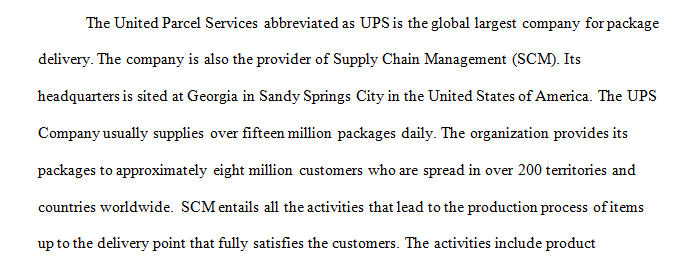Ups company supply chain managment
Summary of Article, SWOT Analysis, Personal Recommendation, and References – doublespaced,
font 12 Times Roman (if you need such parameters).2) Make thoughtful, professional, analytical contributions – (we are NOT BLOGGING – so
please avoid overly casual conversational style/tone). Approach the article discussion more like
contributing to a panel of experts or a management meeting, where intellect, getting to the point,
and supporting references are important. Intellectually support the discussion around the issues
posed in the article. Use and show your knowledge of text book theories, methods and other
outside references to make your contributions more effective. Use separate paragraphs to break
up your various points. Have good descriptive headings.
3) Use Good English – Have perfect spelling, grammar, verb tense, and punctuation. Use action
wording, not passive language like the “to be” verbs (to be, was, were, which, has been, is, could
have been, should have been, and the like). Have Spell / Grammar Checks turned ON in MS
Word. Percentage of passive wording is measured in MS Word (shoot for 5% passive wording).
Active wording is sought and graded. Avoid obtuse/wordy language, and filler/buzz words like
“huge”, “really”, “lots of”, etc. Review and preview your work to make sure it is tight, efficient,
and to the point (graduate students expected to deliver graduate caliber work – fully understood,
and ready to act on). Look up words like “wordy” and “obtuse” to understand further.
4) Title Page – The course name, course number, the title of the article discussion, the date
submitted, and your name (separate page).
5) Introductory Summary of the Article discussion – the key points of the article discussed in a
way that sets up the SWOT Analysis and Recommendation(s) (1 page maximum)
6) SWOT Analysis – a snapshot of the items impacting the issues discussed in the article (1 page
minimum). SWOT stands for (S)trengths and (W)eaknesses – the internal organizational forces;
(O)pportunities and (T)hreats – the external organizational forces. Your analysis should use these
specific terms. Show them clearly as bold headings, etc. (2 pages maximum)
Examples: fiscal power, leadership skills in SCM, advanced research, cutting edge IT are
examples of STRENGTHS; financial problems, poor SCM leadership, or production problems
are examples of WEAKNESSES; an opening window to gain market share, or improve SCM are
examples of OPPORTUNITIES; a competitor’s new product, a change in a competitor’s SCM
process, potential lawsuits, or lost market share are examples of THREATS.
Explain WHY the SWOT item qualifies as such, and HOW it impacts the issues. I want you
FORMAT REQUIREMENTS FOR ALL SUPPLY CHAIN MANAGEMENT (SCM) ARTICLES
eating, drinking and sleeping SWOT – the language of basic business analysis. It will help you in
the rest of your MBA classes, and at work too!
If you cannot present to management in their own language, then your recommendations may fall
on “deaf ears”. SWOT is a language of leadership, so use SWOT to make your points understood
by those who make decisions, and determine your success or failure. Improve your management
communications skills!
7) Personal Recommendation(s) – After the SWOT Analysis, make excellent personal
recommended action(s) using the format “I personally recommend the following specific
action(s).” In other words, take ownership of your actions. (1/2 to ¾ page maximum)
Make sure these are specific, measurable and attainable actions of your own creation – not
something already evident in the article.
Personal Recommendation(s) should improve on SWOT Analysis results, like add or improve a
Strength; fix or minimize a Weakness; maximize or add an Opportunity; minimize or eliminate a
Threat.
8) Reference(s) Page – Cite your references in the body of the analysis including reference name
and page number(s). (separate page)
Show complete referenced sources in APA standard format at the end of the analysis. An APA
Answer Preview for Ups company supply chain managment



